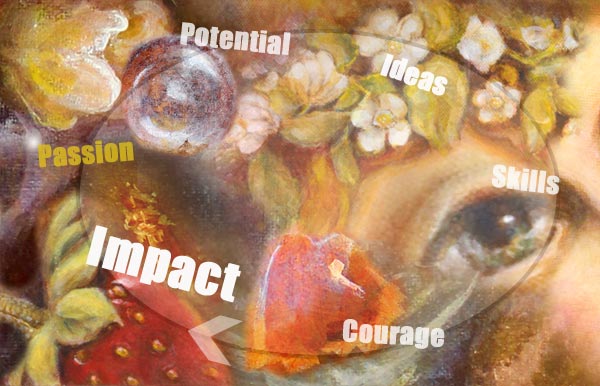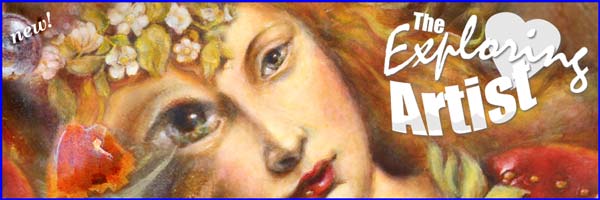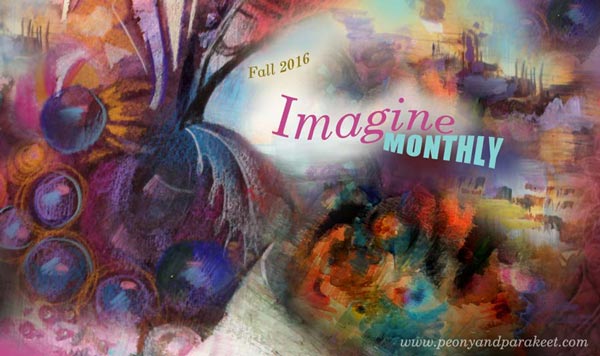Bad Ideas Make You a Better Artist!
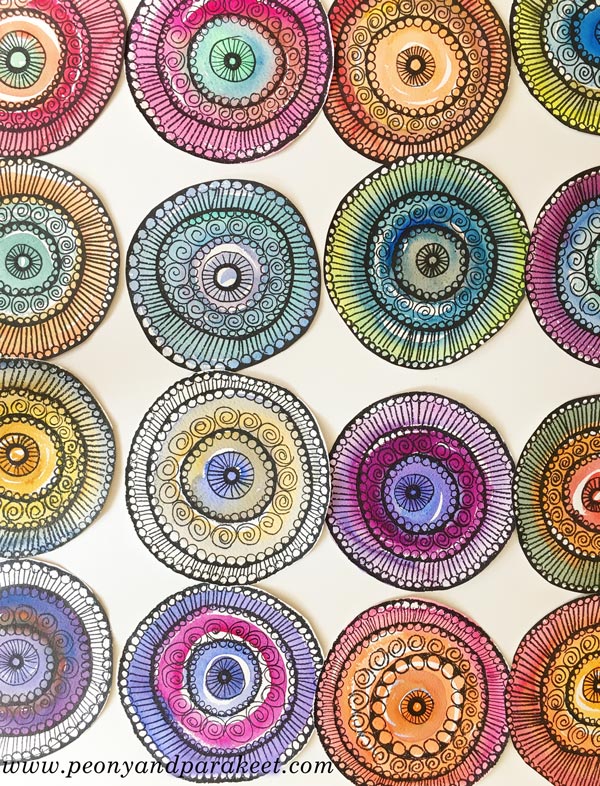
About four years ago, I got a crazy idea to draw doilies on a watercolor paper and cut them out like they would be crocheted pieces.
Handpainted Paper Doilies – Not So Good Idea
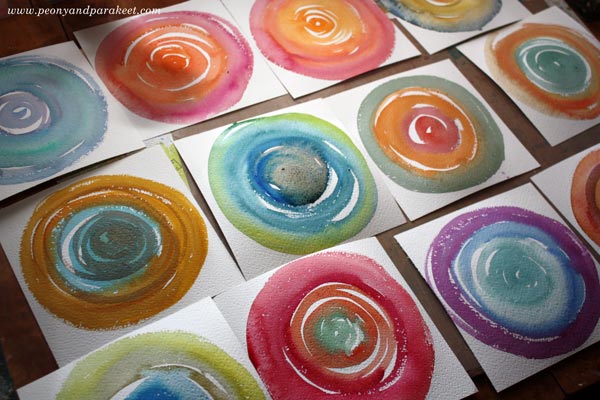
The process of painting the background circles and then decorate them with doodles was so much fun that I got carried away and made plenty.

After I had finished a pile, I enthusiastically showed them to my husband: “Look what I have made!”
– “What are these?”, he said. “What are you going to make from these?”
– “Maybe I share the idea on my blog or make a big wall hanging by joining the circles together. Wouldn’t that be cool!?”
I saw it on his face. He didn’t get it. And furthermore, he didn’t want paper doilies on our walls either.

But to me, the doilies made perfect sense even if they weren’t crocheted. By painting them, I wanted to build a bridge from crafts to art. The paper doily was a raw idea, and as I, fortunately, learned later, raw ideas can look really bad at first.
Big Ideas Come from Bad Ideas
The idea of a doily translated into art didn’t leave me alone. Last year, three years after inventing it, I launched a workshop called Planet Color, where I teach people to paint abstract compositions.
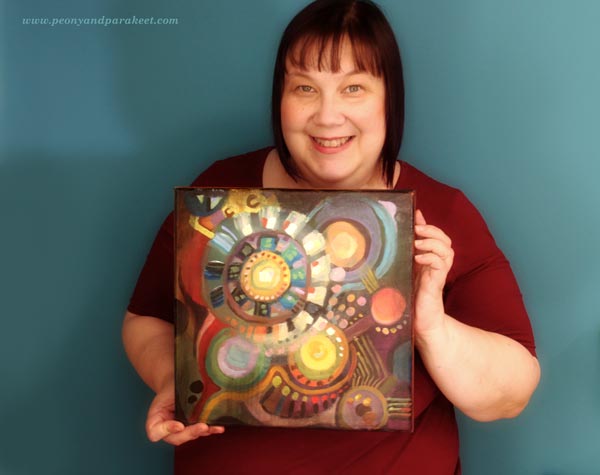
For the class, I needed a lot more ideas. I also needed to build a system and a structure that any beginner can follow. I needed to set it loosely so that everyone can use their imagination, but make it clear so that there would be no room for frustration. The idea of a paper doily was a seed, but it took some time to grow the flower.
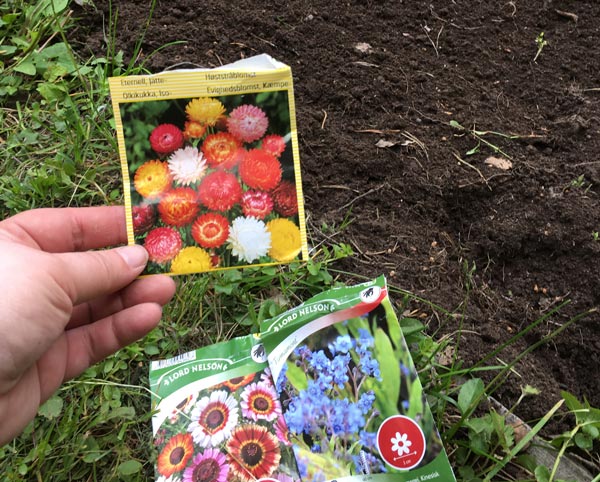
Often when we admire other people’s art, we see the flowers instead of seeds. Most artists don’t show the seeds because many times, like in my case, they are pretty pathetic. Still, it’s the seeds, the raw ideas, that make the published work possible.
Finland 200 – Not So Good Idea
Before I started making a new big painting, I saw some elegant yet simple still lifes in my mind. I had just seen a superb piece of art, a Finnish sculptor Laila Pullinen’s bronze sculpture Spring in Man. So I wanted to start a new painting with the intention to create something grand and dramatic to celebrate Finland’s 100th anniversary. “This would be called Finland 200”, I declared.
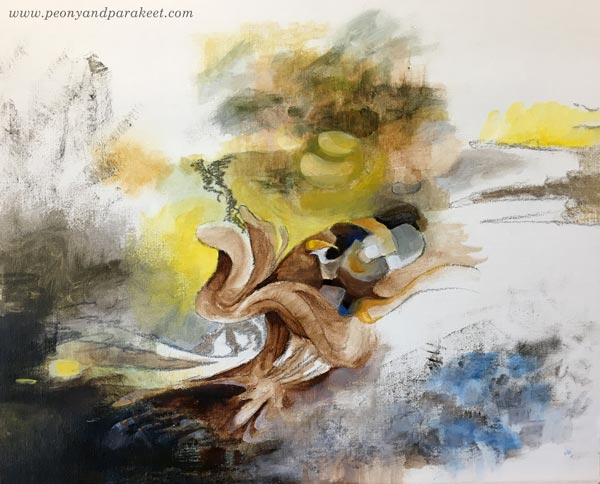
After painting for a couple of hours or so, I began to wonder what I wanted to say. Starting the painting with this much drama felt like a bad idea, and I wasn’t convinced about the centerpiece either. Would that be some kind of mushroom or what? Then my bad ideas just got worse – I decided to continue by writing an imaginary story about Finland after 100 years.
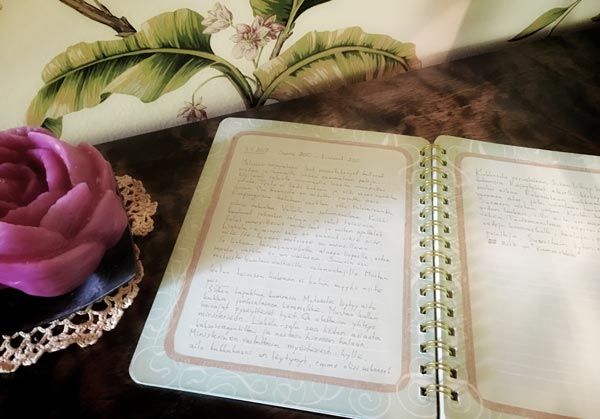
While quickly pouring the words out in my journal, I didn’t realize that I was actually writing a dystopia. The idea of a catastrophe in nature seemed exciting at first, but while painting, I realized that my visuals became very gloomy and weird-looking. I tried to make something positive out of it. I wrote a happy end to my story and painted a pink bubble with rare flowers inside it. That would be a new treasure of Finland, something everyone would want to come and see.

Even if the painting wasn’t finished yet, I already hated it. My original idea was bad enough, and now I had some more. I felt the despair rising.
New Vision – Imagination Takes the Lead
Luckily, I have a secret weapon in these situations. I connect with my passion and use the imagination to go to my happy place. It sets the mood, reminds why I create art and loads the right atmosphere into my mind while I am creating. The side of me that wants to control steps back and the side of me that is good at persuading re-evaluates the work.
– “What about changing the orientation of the painting,” she said.
– “And lose all the hard work?”, my pessimistic side responded.
– “No, nothing would be lost, we would just add a little bit of color to it.”
– “Color? What color?”
– “Brown,” she said cheerfully.
– “Why on earth would I pick brown of all the colors?”
And then she reminded me gently of my passion, about what inspires me and how I can feel free.
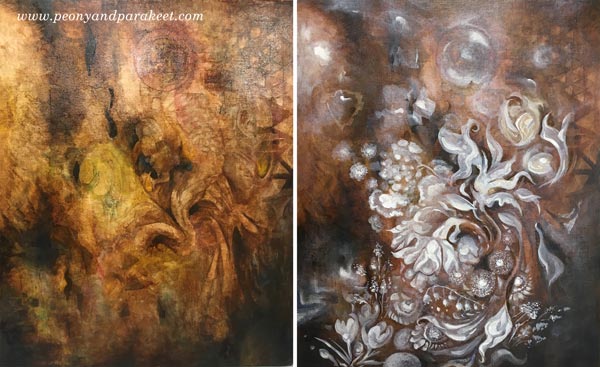
And she was right. I loved the painting after adding layers with umber. It became clear to me what the painting would be. Not Finland 200, but expressing something that has been here for hundreds of years and most probably stays the same for the next hundred: nature’s wonders when exploring the garden. I continued the painting by adding flowers that I have had in the garden. I adjusted the elements in the first layers so that they became the building blocks of the new vision.
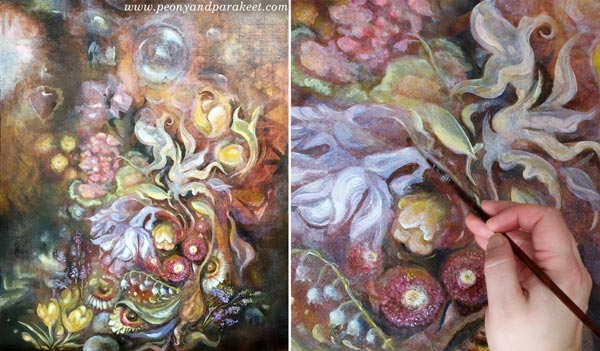
My painting is not finished yet, but it’s already a good example of how the raw ideas can be translated to more inspiring ideas with the help of imagination.
Bad Art, Bad Ideas – Also Behind This Blog Post!
Before I wrote this blog post, I decorated my work planner to get ideas for it. I cut pretty ladies from a wedding magazine and put funny hats on them. While creating this, I thought how this kind of activity would be seen something that a “real artist” would not do, yet it’s essential to me to have a bit of play regularly. So that’s how I got the idea of revealing some bad ideas and how essential this kind of exploration is for producing work that you want to publish.
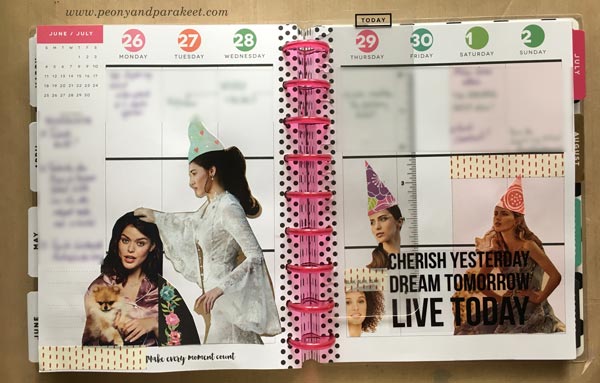
When Your Best Art Exists Only in Your Mind
Before I started making the paper doilies, I had wonderful daydreams inspired by my beautiful yarn stash. By seeing beautiful images in my mind, I came up with my bad idea, the ugly version of those daydreams.
Daydreaming is good, but it’s not successful when you try to translate something you see in your mind to paper. The creative process rarely works so literally. The images in our minds are often vague. Copying them detail by detail is practically impossible. The imagination is more like the leader who supports your art making, not a manager who controls it or the specialist who does the work. During the recent years, I have developed a method of using imagination to connect with the passion of creating art. I teach this method in the group coaching program called The Exploring Artist.
6 Steps to Making an Impact
The Exploring Artist helps you to connect the play with your deeper passion and use that to move forward in all levels of art-making. During this program, you will:
– lead yourself by playing and imagining
– grow ideas from your personal feelings and experiences
– remove blind spots and build skills through the challenges
– get confident in publishing your art, whether it’s just friends or a bigger group of your people
The Exploring Artist is also about connecting and soul-searching within a friendly group. We will work through 6 steps and have live group coaching sessions, where your art and your art-making is in focus.
This is not a class where you create after me and try to get the similar result. It’s for you who wants to get support and guidance for creating freely from your personal standpoint. You can use any media you are comfortable with and apply the methods to your visual project(s). If you feel that you are “all over the place,” and want to find a creative direction, The Exploring Artist is the program for you!
The Exploring Artist will come back in 2018 – Subscribe to my emails to be the first to know!
Knitting and Painting – A Video Visit to My Studio!
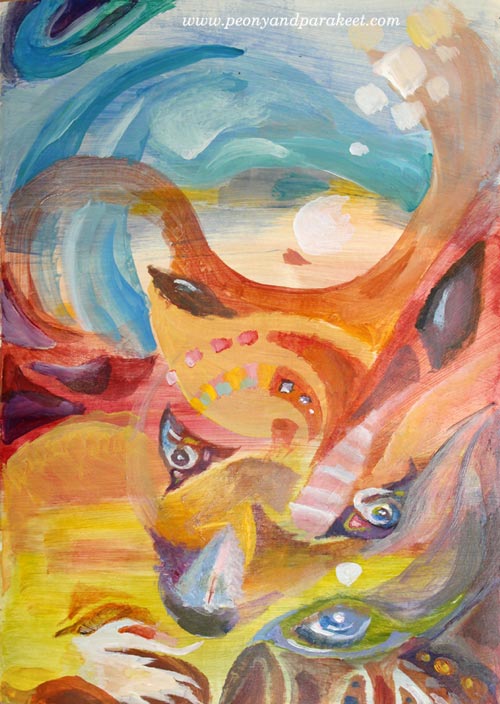
This time I have something for you who likes to watch long videos. I love to knit (especially Leftie scarves) while watching video podcasts, so maybe you can pick up a project too and come to spend some time in my studio, talking about crafts, art inspiration, and painting supplies. I will create a craft-inspired art journal page and show many other pieces too.
A Day at the Studio – One Video in Two Parts
It is a really long video, so I have divided it into two parts. The first part is an introduction to a small project that I paint on the second part. The second part also shows some painting supplies. I hope you will enjoy both of them!
Here’s the first part:
And here’s the second part:
Planet Color is now available as a self-study class: Buy now!
Begin Like a Crafter, Finish Like an Artist
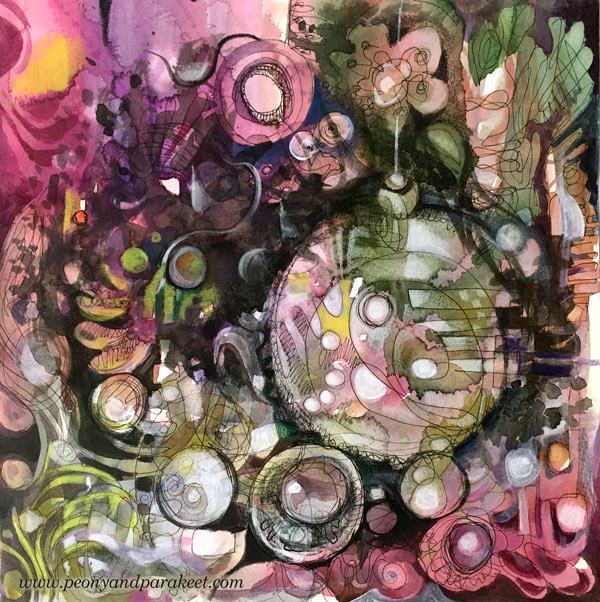
Here’s what I made today: a mixed media painting with a Christmas theme. When I began creating, I had no idea that this will express the season. I didn’t even start with a blank paper but cut a piece of a big pre-painted watercolor paper. It had just careless splotches of color, and I had painted it months before to wait for the right moment. I had just enjoyed knitting some old sock yarn into socks, so I thought to use up that paper with the same mindset: using what I already have and making that more inspirational.
Begin Like a Crafter
I picked a black Zig drawing pen and started doodling without any idea in my mind. I often think about knitting or crocheting when I doodle. I feel more like a crafter than an artist at the beginning of the process. Exploring the paper with a pen is like crocheting with a hook and yarn. It’s much more relaxing than trying to find a grand idea first. When you start as a crafter, you are ready to do the work. You don’t expect miracles to happen, you know you just have to keep on going, and it will get easier after a while.

After filling most of the paper with crossing lines, I felt that there was a lack of connection between the drawing and the background painting. They looked like they were two separate layers, each made by a different person. But because I had used a good quality watercolor paper, I was able to add water and wipe off color here and there so that the layers began to interact.
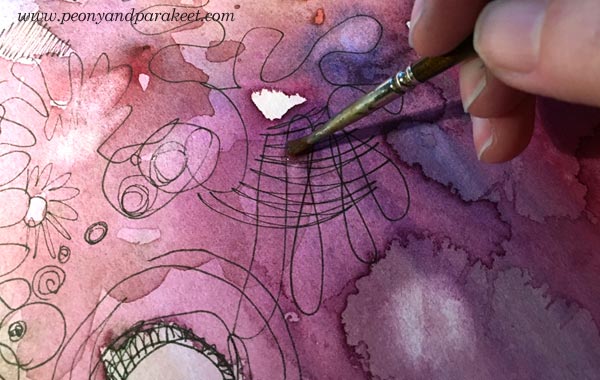
Again, I felt like a crafter adding stitches that would tie the two layers together. I also used white and black colored pencils to enhance the effect.
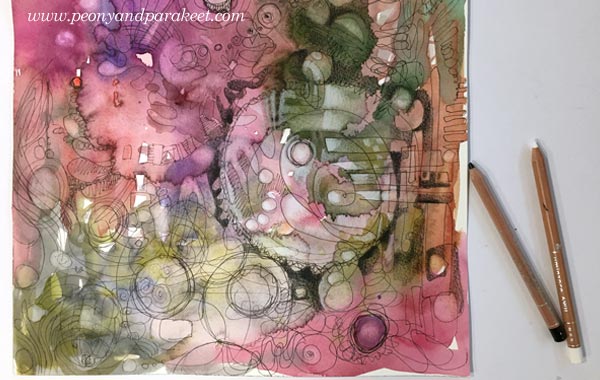
Find Routines that Start the Change
Working with black is my thing. It always brings in more excitement, more drama, and my identity begins to change from a crafter to an artist. This time, just holding a black pencil, made me want to start painting. I picked few bottles of India ink first.
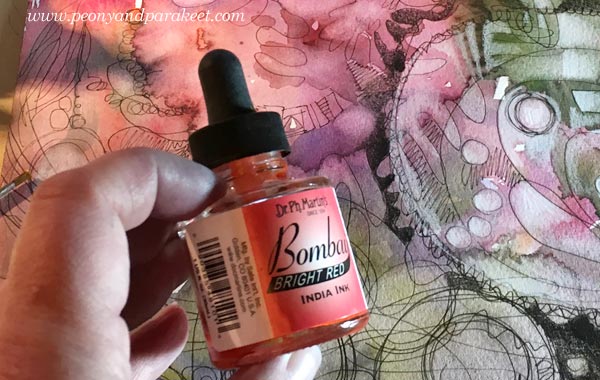
My brush felt stiff, and the shapes that I painted were controlled and modest. But I knew I just had to keep going. There were times when I stopped too soon, and I have seen that happening to many people too. When you stop too soon, you are still too much of a crafter. You try to focus, and you don’t feel like doing anything risky.
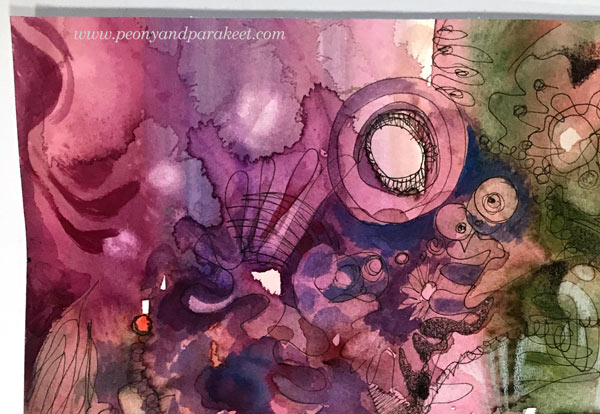
I changed to white acrylic paint to get more ideas and contrasts. There were some round shapes on the paper, but I had no idea what they could be.

Finish Like an Artist – a) Do Something Risky
After spending some time painting, I was ready to take risks. All I needed was to choose a little black ink bottle and turn on Jean-Michel Jarre’s Stardust, a song that always gets me into the flow. Uncontrollable black brush strokes felt scary, and of course, there’s a risk of “ruining everything”. I often set an area, where I don’t go. This time I decided to be as wild as I want but leave the center of the biggest bubble alone.
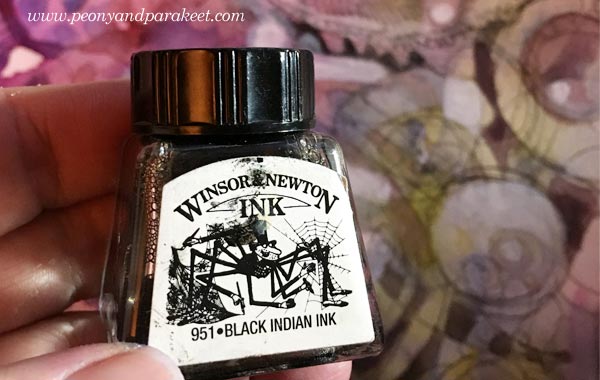
Before doing this phase, I convince myself that my subconscious knows what I could bring up from the mess because I have been staring that for a while already. I often repeat the words “trust” and “knowledge” before I turn to the music. I try to be as quick as I can and focus on adding more speed to my brush. This short phase where I leave the crafter behind is the most enjoyable thing in creating. I feel free while pushing the limits of my creativity.
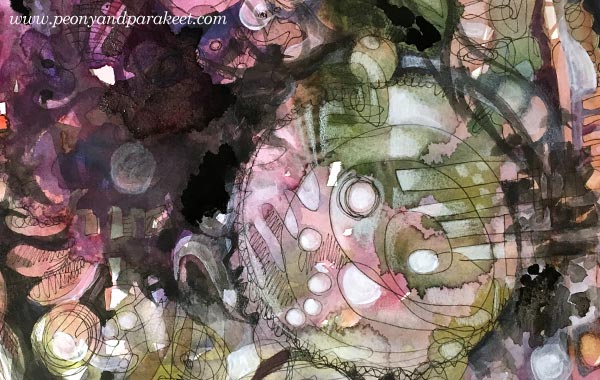
Finish Like an Artist – b) Bring in the Intention
After adding those black strokes and splotches, I knew what I was expressing: holiday decorations on this black Christmas. In the southern Finland where I live, all the snow melt away just before Christmas Eve. I had taken photos just a couple of days ago that connect well with the painting. In this last phase, I try to find the fastest and most natural route to finishing the painting and focus more on composition and clarity than trying to make the image other than what it seems to be already. Accepting that my image can go to the area that is unknown to me at the beginning of the process, allows me to be less stiff.
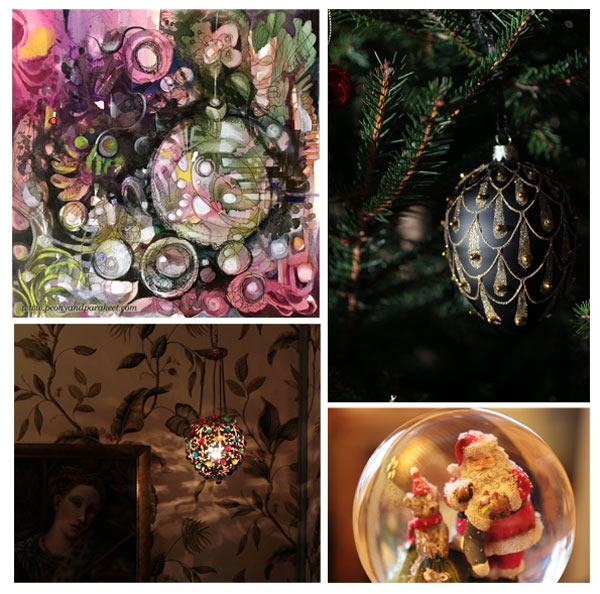
I find it so fascinating that art is a combination of knowledge and letting go. There are clear guidelines for communicating visually such as how to set your composition. And still, it’s also about taking all that knowledge and jumping into the unknown. Every day, I want to know more and then, relax more!
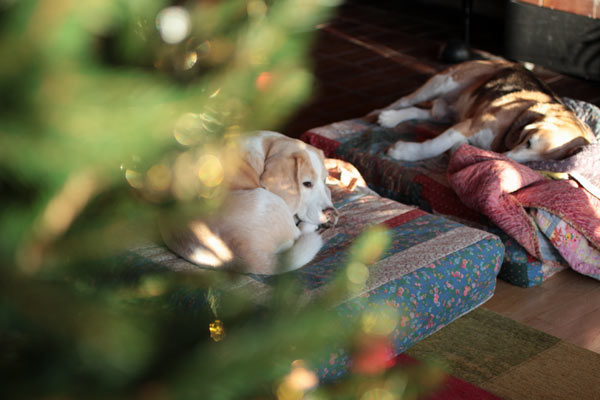
First Lesson of Inspirational Drawing 2.0 – Start with a Mood, Finish with an Image!
Like knitting starts from the first stitch, drawing starts from the first line. Somewhere between the lines the transformation happens and the crafter changes to an artist. The ideas grow with the imagination. Moods turn to motifs, motifs to modules, modules to streams, streams to images.
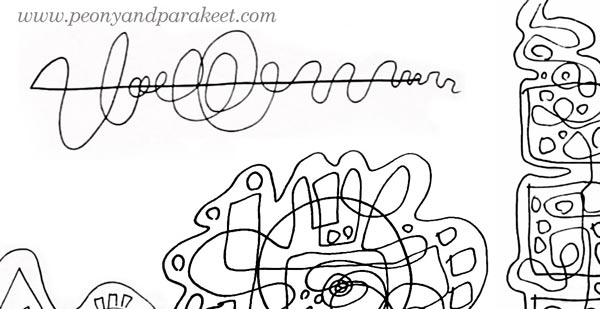
The first lesson of Inspirational Drawing 2.0 will be published on January 1st. This is the class you don’t want to miss! Every lesson takes you further in enjoying drawing from inspiration and imagination! I will help you create unique art in unique ways that will make you absorb the knowledge and then let your ideas grow.
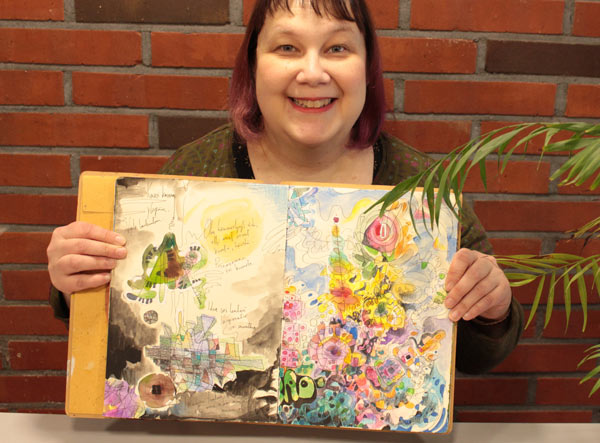
Enjoy drawing from inspiration and imagination!
>> Sign up for Inspirational Drawing 2.0
Limited Creative Time – A Personal Story
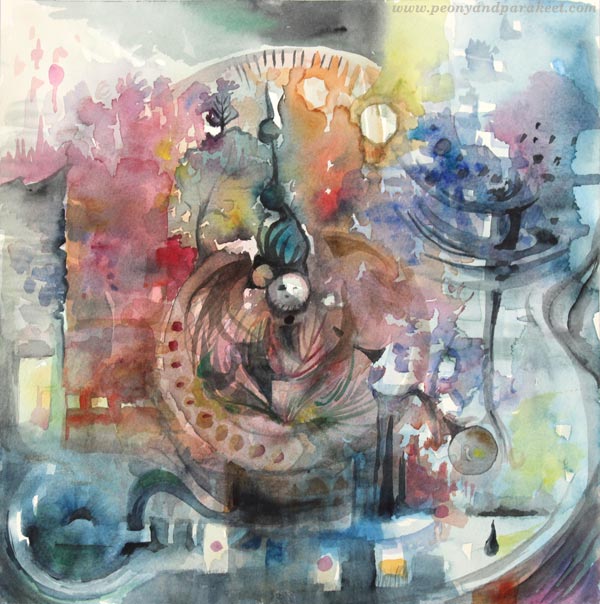
Here’s my latest watercolor painting “The Sense of Time”, made just a couple of days ago. I limited my creative time immensely when painting this. But this time I want to share the whole story, not just images of how I made the painting. At the same time, you will see some of my summer crafting projects and learn a couple of fun facts about Finnish summer.
Peonies Embrace the Midnight Sun
When people ask what would be the best time to come to Finland, I always suggest summer. Finnish summer begins in June and ends in August. In my opinion, the best month is July. Even in the south, where I live, you can experience the midnight sun, warmth and see the best in Finnish people. Like peonies, we are all introverts in the dark and cold winter, But when the sun comes up, it’s all smile.

Colors Compete with Shapes
My husband always has his summer vacation in July. As dog owners, our possibilities to travel are limited to day trips unless we take them to kennels or arrange somebody to look after them. As both of us love old art and antique, we always go to Billnäs and Fiskars for an antique fair. If you have watched a British television series Lovejoy, these are the places where you could see him and his assistants if they traveled to Finland. There are two antique fairs at the same time. They last 4 days and are packed with people selling and buying antique items in the middle of Finnish countryside. The fairs are partly indoors, partly outdoors and truly a collector’s heaven whether it rains or shines.
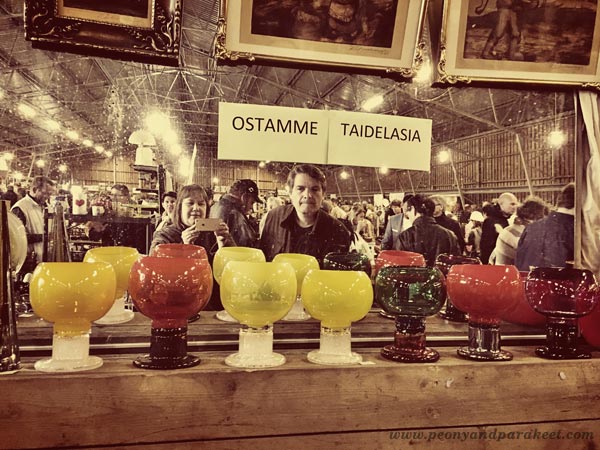
When looking at the sales tables, I always notice color first. My husband, a skillful woodworker, examines the shapes. Together we are unbeatable!
Art Rises from the Dollhouse
It was both unfortunate and fortunate that I found an old display cabinet from Billnäs. Fortunate, because it’s just what I had dreamed of for my doll collection. Unfortunate, because I didn’t have the space for the dollhouse anymore. I had to empty the tiny kitchen with miniature wine bottles and delicacies as well as all the other tiny rooms filled with similar items.
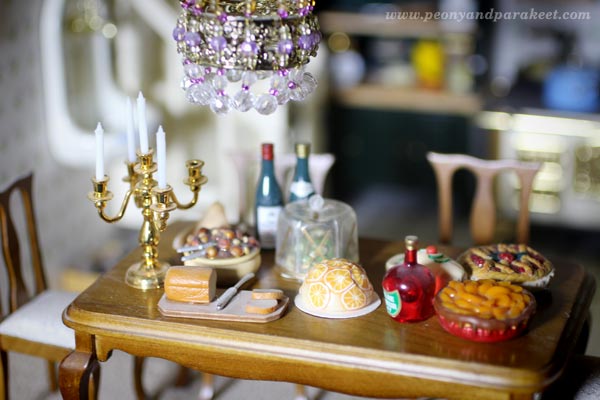
While taking the little paintings off from the walls, I realized that one of them wasn’t just printed image. It was a cross-stitch project that I had made years ago! I remembered not being very happy with it. When I started it, I thought that I could make more than one and then sell some. I didn’t have any pattern and the end result didn’t look as painterly as I would have wanted. So I gave up the idea of making more and placed the piece above the dining table, in the spot where it wasn’t as visible as other pictures. No wonder I had forgotten it!
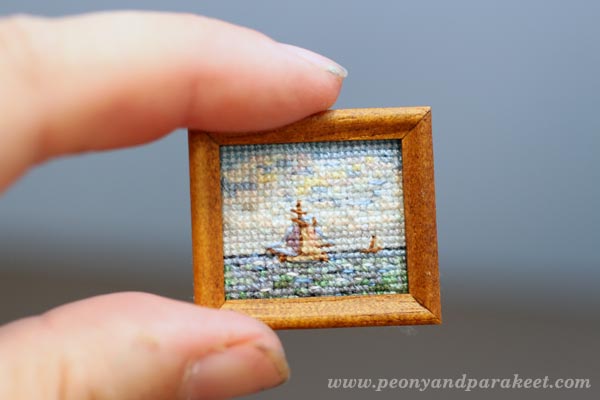
But now, it looks just perfect to me. Now I see more than just clumsy stitches. I see how my love to combine arts, crafts and design came out even when I was decorating a dollhouse.
William Morris Visits Ikea
One of my creative routines is organizing things. Even at antique fairs, I sometimes get the urge to rearrange items and I have to restrain myself. This spring, I was organizing a storage space of our house and found an old Ikea Moppe mini chest of drawers. Putting old stuff to use is a creative challenge that I am often willing to take. I went to Pinterest, saw boards like this and was ready to get started.
The first challenge was that I also wanted to use up old paints. The only paint with the suitable quality was baby blue. I wanted to place the mini chest in the library room near my doll collection and store fashion doll clothes in it. I had a hard time seeing baby blue suit to the style and color scheme of the library room. We have decorated the library room in the styles of 1890-1930s. The curtains have William Morris’s pattern. How could the Ikea mini chest ever with the style? Trusting that I could figure it out, I refused to buy new paint as I had another purchase in mind. I wanted to buy ceramic knobs for it.
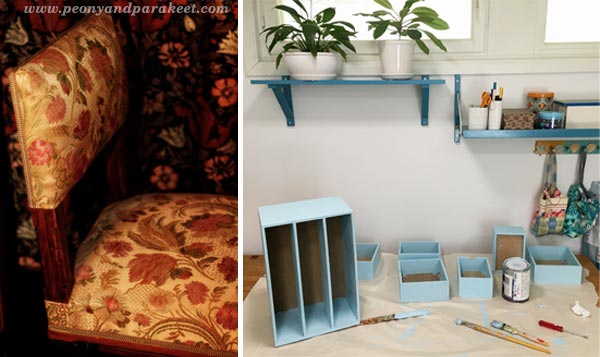
If I had to choose one material that I adore, it would be a difficult decision between ceramics and glass. But I think the winner would be ceramics. Even if I have never really dived deep into creating with clay, I love ceramic items. Especially if they are both decorative and expressive. I also like them to be a little rustic, have some handmade feel without being overly clumsy. The knobs I wanted to buy should also have some baby blue, some William Morris, look both old and modern and be traditional but somewhat innovative. Despite the high expectations, I optimistically began to search handmade ceramic knobs. It took a couple of days but my optimism paid off and I found just the perfect ones! They are made by an English woman living in Israel. Her Etsy shop is called “Clay is My Art”, a heaven for anyone who loves rustic, but sophisticated ceramics.

As you can see in the photo, I was able to find decorative papers that not only matched the knobs, they fit perfectly to the style of the library room. The papers with palm plants are leftover wallpapers. The other two are from my scrapbooking paper stash.
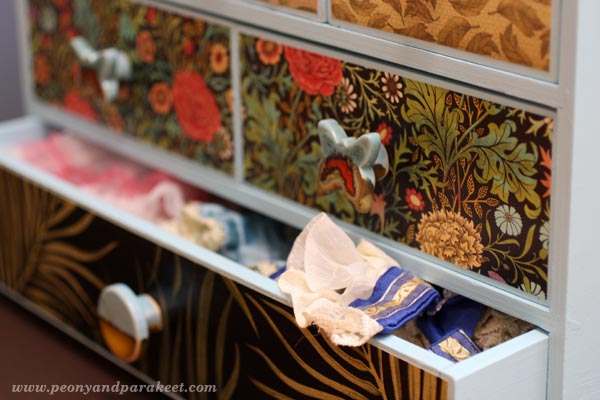
But wait, this story continues …
Leftover Flosses Praise the Pattern
Have you ever had anything in your home that was ok before you changed everything in its surroundings? My number one thing was a small key storage cabinet, which was fine in our old home on a muted dark red wall. But when placed on a bright yellow wall of our current home, it really bothered me. With the experience in cross stitching for dollhouses, I got an idea of stitching a dollhouse carpet pattern from Janet Granger‘s book Miniature Dollshouse Carpets.
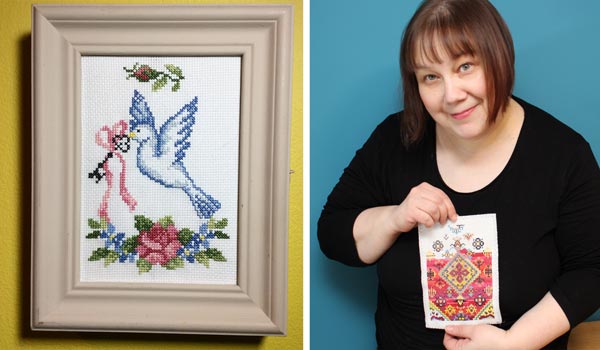
It took all spring when working slowly but at the beginning of summer, I got it stitched. I also repainted the wooden parts. This time I did buy the dark green paint but this is still a project using leftovers. Namely, I didn’t just use the few colors set in the pattern. I used leftover skeins of embroidery floss creatively so that the carpet looks like an old antique one. I much prefer this look to using only a few colors.
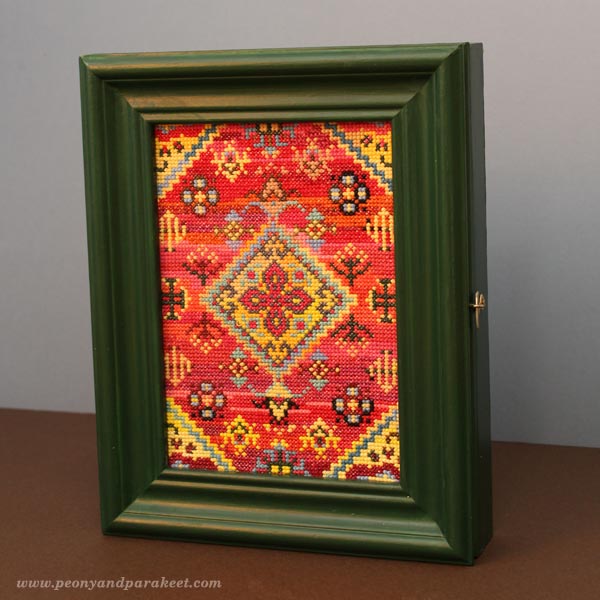
The cabinet looks great on the yellow wall. I temporarily took it down for photographing it in a better lighting. There was also another reason, connected to the watercolor painting …
Limited Creative Time – Craft Projects Inspire the Painting
This time I had limited creative time. Before I started painting, I placed the three handcrafted items on the table in front of me. The key cabinet, the mini chest and the miniature cross-stitch work were all there to inspire me. Then I glanced my watch and gave myself 15 minutes to paint the first layer. Namely, I had another project in progress too. I was editing one of the videos for Imagine Monthly Fall, the art journaling class that begins on August 1st. Editing videos requires a lot of concentration and I wanted to keep the quality good by taking small breaks. So after 45 minutes of editing, I had 15 minutes for my painting, all day.
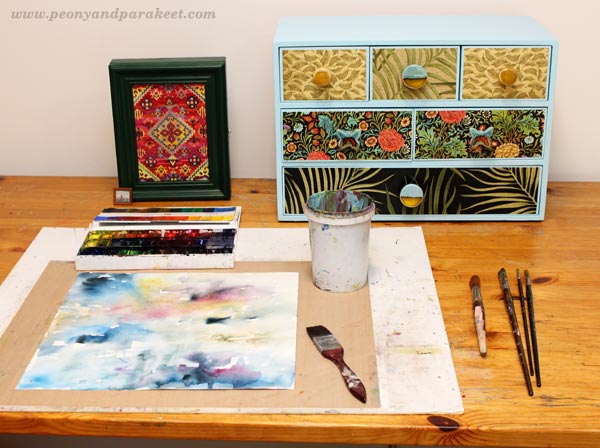
If you work in short periods of time like this, inspiration items become essential. Seeing the same objects again and again, even if you are not actually recreating any of them, maintains the focus and direction.
After four 15 minute sessions I was at the point where I had painted this and that with five different brushes but had no clue of what I was trying to express. It was fun to paint like this but clearly, I couldn’t finish the painting without setting up a longer session.
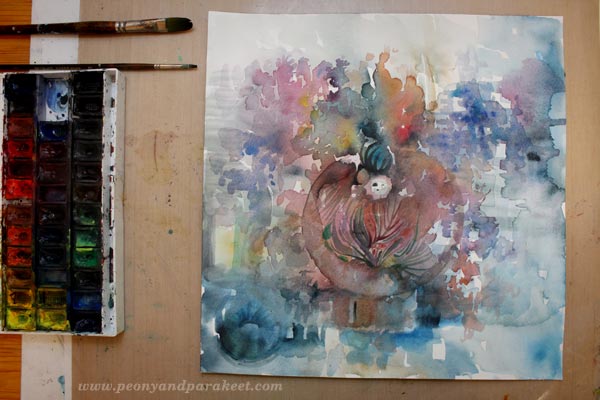
Finishing – Summing Up
I soon discovered that being so aware of the time had also affected the painting. I saw clocks and pointers which made me ponder about the concept of time. It flies so quickly in creative activities that it’s difficult to think about it as a simple measure. This, in turn, made me think about the antiques and how great designs last time. After my husband and I are gone, there will always be new enthusiasts who will drool over those Kaj Franck‘s bowls.
I often finish my watercolors with colored pencils to easily add new layers of details and decorative lines. But this time, I was reminded of my craft projects: “Make the most of what you currently have.” So I resisted the urge to go to another room and get the jars of colored pencils. It only took an hour to finish the painting.
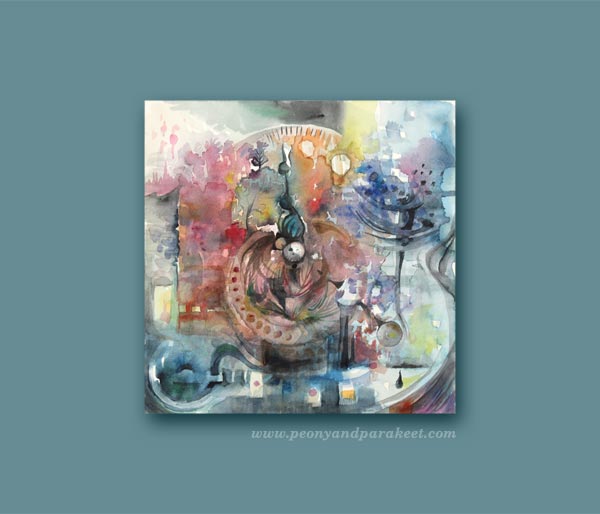
Some midnight sun, some glassware, mini horizons, small amounts of leftover colors, block shapes and last but not least: the description of how my inner artist sees the sense of time.
The Way I Process Ideas and Produce Classes
This blog post demonstrates how I work with ideas. It’s not only one idea that goes into one piece of work, it’s a collection of ideas that have different levels. Some are more abstract, others are more concrete. I believe that every good art class is filled with multi-level ideas that in turn, embark your own ideas. That’s why I never underestimate the importance of the background study that I do for my classes. I listen to audiobooks. I go to libraries to browse books. I collect Pinterest boards and inspirational items. I make sketches and paintings that I call pre-class paintings (yes, the one above is one of these). They prepare me to bring my best to the classes that I produce. They ensure that the class is not only about one whimsical thing that I fell in love with but about a holistic, yet clear and inspiring view to the subject. All in all, we all have limited creative time.
Sign Up for Imagine Monthly Fall!
Take your art to a new level by practicing drawing and painting with themes inspired by fine arts. Express prestigious nostalgia, impactful aesthetics, and futuristic imagination through art journaling. Let’s make idea-full art journal pages your channel to move forward in art making!
Imagine Monthly Fall 5 challenges, great community >> Sign up now!
